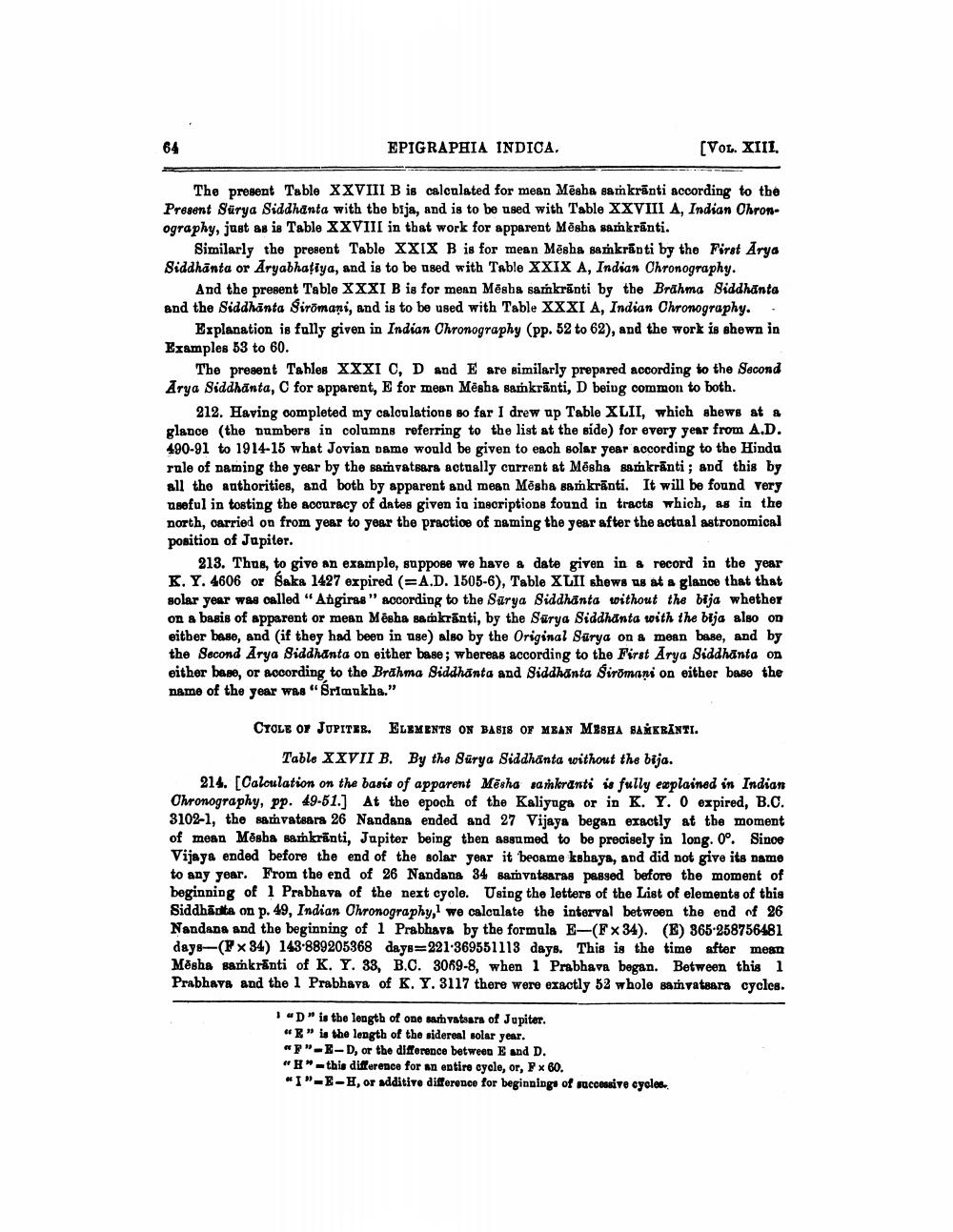________________
EPIGRAPHIA INDICA,
(VOL. XIIL
The present Table XXVIII B is calculated for mean Mesha sam krānti according to the Present Sürya Siddhanta with the bija, and is to be used with Table XXVIII A, Indian Ohron. ography, just as is Table XXVIII in that work for apparent Mēsha samkrānti.
Similarly the present Table XXIX B is for mean Mēsha sankranti by the First Arya Siddhānta or Aryabhatiya, and is to be used with Table XXIX A, Indian Chronography.
And the present Table XXXI B is for mean Mēsba samkrānti by the Brahma Siddhanta and the Siddhānta Siromani, and is to be used with Table XXXI A, Indian Chronography. .
Explanation is fully given in Indian Chronography (pp. 52 to 62), and the work is shewn in Examples 53 to 60.
The present Tables XXXI C, D and E are similarly prepared according to the Second Arya Siddhānta, C for apparent, E for mean Mēsha samkrānti, D being common to both.
212. Having completed my caloulations so far I drew up Table XLII, which shews at a glance (the numbers in columns referring to the list at the side) for every year from A.D. 490-91 to 1914-15 what Jovian Dame would be given to each solar year according to the Hindu rule of naming the year by the samvatsara actually current at Mosha samkrānti; and this by all the authorities, and both by apparent and mean Mösha samkrānti. It will be found very Useful in tosting the accuracy of dates given ia inscriptions found in tracts which, as in the north, carried on from year to year the practice of naming the year after the actual astronomical position of Jupiter.
213. Thus, to give an example, suppose we have a date given in & record in the year K. Y. 4606 or Saka 1427 expired (=A.D. 1505-6), Table XLII shows us at a glance that that solar year was called "Angiras" according to the Sarya Siddhanta without the bija whether on a basis of apparent or mean Mēsha sankranti, by the Sürya Siddhanta with the bija also on either base, and (if they had been in use) also by the Original Sürya on a mean base, and by the Second Arya Siddhanta on either base; whereas according to the First Arya Siddhanta on either base, or according to the Brahma Siddhanta and Siddhanta Siromani on either base the name of the year was "Srimukha."
CTOLE OF JUPITER. ELEMENTS ON BASIS OF MEAN M88A BAÁKRINTI.
Table XXVII B. By the Sürya Siddhānta without the bija. 214. [Calculation on the basis of apparent Mēsha sankranti is fully explained in Indian Chronography, pp. 49-51.) At the epoch of the Kaliyuga or in K. Y. O expired, B.C. 3102-1, the samvatsara 26 Nandana ended and 27 Vijaya began exactly at the moment of mean Mosba samkrānti, Jupiter being then assumed to be precisely in long. 0°. Since Vijaya ended before the end of the solar year it became kshays, and did not give its name to any year. From the end of 26 Nandana 34 samvatsaras passed before the moment of beginning of 1 Prabhava of the next cycle. Using the letters of the List of elements of this Siddhānta on p. 49, Indian Chronography, we calculate the interval between the end of 26 Nandana and the beginning of 1 Prabhava by the formula E-(F x 34). (E) 365-258756481 days-(P x 84) 143-889205368 days=221-369551113 days. This is the time after mean Mēsha samkranti of K. Y. 33, B.C. 3069-8, when 1 Prabhava began. Between this 1 Prabhava and the 1 Prabhava of K. Y. 3117 there were exactly 52 whole samvatsara cycles.
I
D " is the length of ono sam vatsara of Jupiter. "E" is the length of the sidereal solar year. "F"-E-D, or the difference between E and D. " " this difference for an entire cycle, or, P x 80. "1-E-H, or additive difference for beginnings of successive cycles




